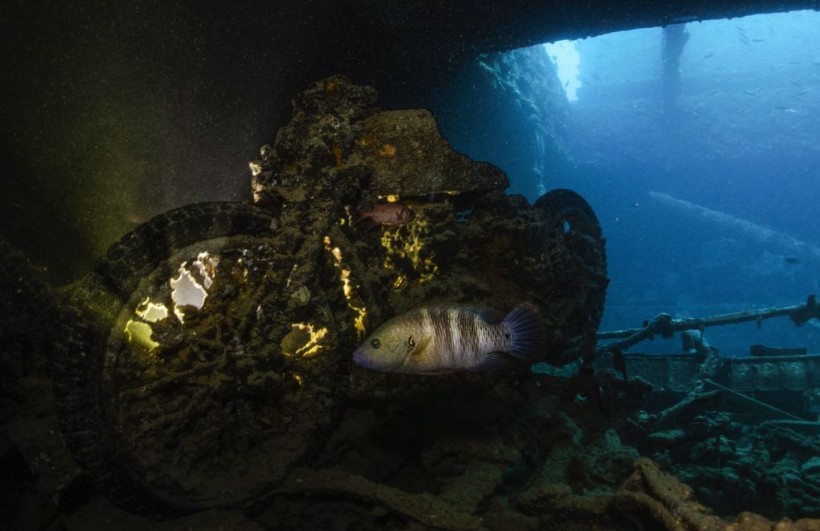The shipwreck SS Thistlegorm was destroyed off the coast of Egypt by a German bomber in 1941, yet it has found new life as an artificial coral reef. Between 2007 and 2014, divers counted the number of coral and fish species they saw in the WWII wreckage and discovered 71 distinct variations.
Their presence varied according to the season, as MailOnline reported, suggesting that artificial coral reefs may retain a well-established community similar to their natural counterparts.

This picture was taken on September 3, 2018, shows a broom tail wrasse (Cheilinus lunulatus) swimming past a Birmingham Small Arms (BSA) motorcycle on the shipwreck of the SS Thistlegorm, near the Egyptian Red Sea marine reserve of Ras Mohamed, off the southern tip of the Sinai peninsula.
History of SS Thistlegorm
Joseph Thompson & Sons in Sunderland, England, built SS Thistlegorm, according to the website Scuba Diving. The 415-foot steamship was owned and operated by the Albyn Line and was launched in June 1940. A 4.7-inch anti-aircraft gun and a heavy caliber machine gun were added to the ship when it was called into the war effort during the World War II era.
However, German intelligence indicated a big troop transport ship in the vicinity sometime during the Thistlegorm's passage to the Red Sea. The Luftwaffe aerial branch of the German military ultimately sent bombers to strike the transport ship on the night of October 5, 1941, but Thistlegorm had already arrived at its final mooring.
When two German twin-engine Heinkel He111 bombers failed to locate their target, they split up, hoping to find another purpose for their payload on their trip back to Crete. They found the Safe Anchorage F and chose the most significant ship they saw, the Thistlegorm.
One of the planes swooped in and dropped two bombs that hit the cargo ship at 1:30 am on October 6, 1941. It hit the ammunition stored in the ship, which caused a strong explosion that ripped it in half. The explosion was too bright that it caught the attention of the other Luftwaffe plane, which came back and completely sank the ship two days later.
SS Thistlegorm Is Now a Famous Red Sea Dive Site
The rusting shipwreck resting 105 feet (32 m) underwater has become a famous Red Sea dive site. MailOnline reports that this is because a large variety of species of marine life now call it home and has made it a colorful spectacle for scuba divers.
Researchers said that sunken warships, such as this shipwreck, have been known to serve as exceptionally good artificial substrates for coral reefs since they offer a multitude of opportunities for microhabitats. Still needing sunlight, these structures in cold water provide a home for species trying to escape the warming, shallower waters.
In the study, titled "Eight years of community structure monitoring through recreational citizen science at the "SS Thistlegorm" wreck (Red Sea)," published in PLoS ONE, researchers assessed the development of the SS Thistlegorm reef within eight years. They found over 70 fish and coral species after undertaking 390 surveys on the shipwreck.
The findings show that SS Thistlegorm displays characteristics similar to other artificial reefs. Indeed, similar shipwrecks have also been found to protect marine biodiversity from fishing activities.
The presence and abundance of each species seen by divers on the shipwreck corresponded to natural seasonal and temperature changes. They did fluctuate dramatically year after year, but there was no discernible trend. They hope to conduct further study on the temperature of the biodiversity of artificial reefs and compare it to natural reefs.
RELATED ARTICLE: Titanic Wreck High-Definition 8K Video Reveals Exciting, Never-Before-Seen Details 110 Years After It Sank
Check out more news and information on Shipwreck in Science Times.




![Earth's Quasi-Moon Kamo‘oalewa Could Originate From Lunar Surface Not Asteroid Belt [Study]](https://1721181113.rsc.cdn77.org/data/thumbs/full/53275/89/56/50/40/earths-quasi-moon-kamo-oalewa-could-originate-from-lunar-surface-not-asteroid-belt-study.png)









